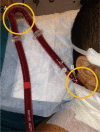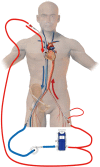Veno-venous extracorporeal membrane oxygenation: cannulation techniques
- PMID: 28149575
- PMCID: PMC5227239
- DOI: 10.21037/jtd.2016.12.88
Veno-venous extracorporeal membrane oxygenation: cannulation techniques
Abstract
The development of extracorporeal membrane oxygenation (ECMO) technology allows a new approach for the intensive care management of acute cardiac and/or respiratory failure in adult patients who are not responsive to conventional treatment. Current ECMO therapies provide a variety of options for the multidisciplinary teams who are involved in the management of these critically ill patients. In this regard, veno-venous ECMO (VV-ECMO) can provide quite complete respiratory support, even if this highly complex technique presents substantial risks, such as bleeding, thromboembolic events and infection. While VV-ECMO circuits usually include the cannulation of two vessels (double cannulation) in its classic configuration, the use of a single cannula is now possible for VV-ECMO support. Recently, experienced centers have employed more advanced approaches by cannulating three vessels (triple cannulation) which follows veno-arterio-venous (VAV) or veno-arterio-pulmonary-arterial cannulation (VAPa). However, 'triple' cannulation expands the field of application but increases the complexity of ECMO systems. In the present review, the authors focus on the indications for VV-ECMO, patient assessment prior to cannulation, the role of ultrasound-guided vessel puncture, double lumen single bicaval cannulations, and finally triple cannulation in VV-ECMO.
Keywords: Respiratory failure; veno-venous extracorporeal membrane oxygenation (VV-ECMO).
Conflict of interest statement
The authors have no conflicts of interest to declare.
Figures








References
Publication types
LinkOut - more resources
Full Text Sources
Other Literature Sources
Miscellaneous
